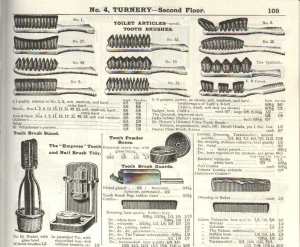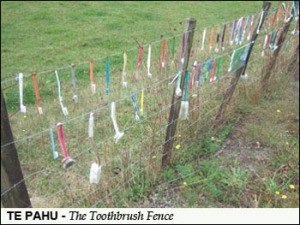Researching family history can take you off in the strangest of directions. I would never have imagined myself reading up on the history of toothbrushes, but when I came across a relative with the intriguing occupation of “Toothbrush Profiler”, I just had to find out more.
It turns out that my husband’s great grandfather wasn’t alone, and that in the early 1900s, a whole street of people in the village of Combe St Nicholas, near Chard in Somerset, devoted their working lives to the manufacture of toothbrushes.
We have the Chinese to thank for the original design of the bristle toothbrush, similar in style to the ones we use today. Way back in 1498 they designed a brush using the stiff hairs from the back of a boar’s neck attached to bone or bamboo handles. When the design was adopted in Europe, softer hairs were also often used, such as horsehairs, or even feathers!
 William Addis was responsible for the first “modern” design to be introduced in England in around 1780. The handle was carved from cattle bone and the brush portion was still made from swine bristles. In 1844, the first 3-row bristle brush was designed. From talking to my mother-in-law, this sounds like the design which she remembers her grandparents putting together when she was a small child. She said that dark-coloured bristles formed a stripe in the centre, with softer, lighter-coloured ones on the outside. The bristles were drawn (hence another similar occupation at that time, “Brush drawer”) through holes in the handle using fine wire. A “Toothbrush Profiler”, presumably, was responsible for trimming the bristle ends into different shapes.
William Addis was responsible for the first “modern” design to be introduced in England in around 1780. The handle was carved from cattle bone and the brush portion was still made from swine bristles. In 1844, the first 3-row bristle brush was designed. From talking to my mother-in-law, this sounds like the design which she remembers her grandparents putting together when she was a small child. She said that dark-coloured bristles formed a stripe in the centre, with softer, lighter-coloured ones on the outside. The bristles were drawn (hence another similar occupation at that time, “Brush drawer”) through holes in the handle using fine wire. A “Toothbrush Profiler”, presumably, was responsible for trimming the bristle ends into different shapes.
The invention of nylon by the chemist Wallace Carothers at DuPont in 1938 was revolutionary in so many ways, but ultimately brought an end to this curious profession, as automated toothbrush manufacture took over.
Anyone who wants to see historical toothbrushes “in the flesh” should take a trip out to Hertfordshire, where Hertford Museum houses the UK’s largest collection, with over 5000 examples made from bone, wood, plastic and aluminium.
 And if you fancy venturing further afield to indulge in weird toothbrush-watching fantasies, why not pay a visit to the Toothbrush Fence in Te Pahu in New Zealand? Yes, it’s just a fence with toothbrushes hanging from it, but you’ve got to admire their wonderful profiles!
And if you fancy venturing further afield to indulge in weird toothbrush-watching fantasies, why not pay a visit to the Toothbrush Fence in Te Pahu in New Zealand? Yes, it’s just a fence with toothbrushes hanging from it, but you’ve got to admire their wonderful profiles!
